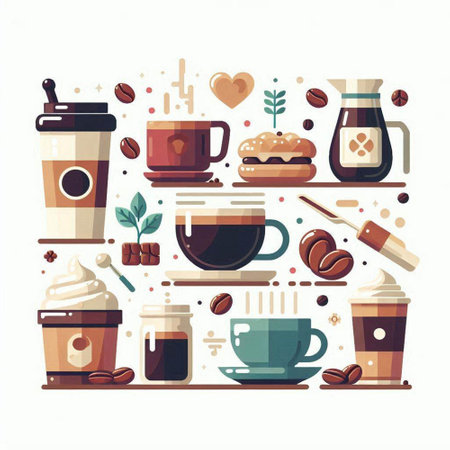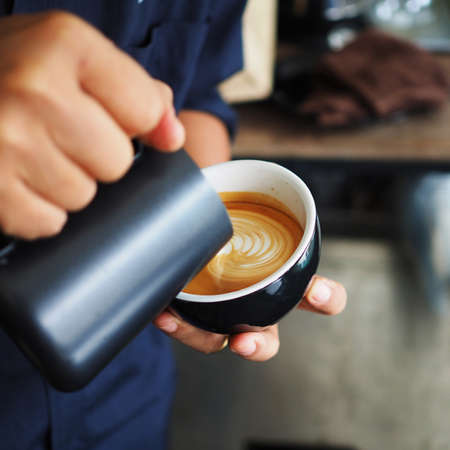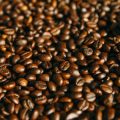1. The Art and Science of Brewing
When it comes to brewing the perfect cup of coffee, today’s professional baristas in the United States approach their craft with both creativity and scientific precision. Over the years, what started as a simple morning ritual has evolved into a highly detailed process, especially on the competition stage.
The Evolution of Coffee Brewing
Coffee brewing in America has come a long way from classic drip machines and diner cups. Specialty coffee shops and competitions like the US Barista Championship have transformed how people think about coffee. Now, baristas use advanced techniques and tools to highlight every note and nuance in each cup.
Turning Craft Into Competition
Professional barista competitions are more than just making coffee—theyre about mastering the details. Judges look for consistency, flavor balance, and presentation, pushing competitors to treat brewing as both an art and a science. Every variable matters: from water temperature to grind size, nothing is left to chance.
Key Tools: Kettles and Scales
| Tool | Purpose in Competition |
|---|---|
| Kettle (often gooseneck) | Controls water flow rate for even extraction |
| Scale (digital, high precision) | Measures coffee dose and water weight accurately |
This careful approach allows baristas to repeat their best recipes under pressure. For example, using a scale ensures that every shot or pour-over is brewed with exact ratios—something that can make or break a competition routine.
Why Precision Matters
Just like baking, small changes in measurements can lead to big differences in taste. By treating brewing as a science, American baristas raise the standard for quality—and inspire coffee lovers everywhere to appreciate the details behind every cup.
2. Why Kettles Matter: Precision Pouring Explained
When it comes to brewing the perfect cup of coffee, every detail counts—especially in a competition setting where professional baristas aim for consistency and precision. One tool that stands out in their arsenal is the kettle, particularly specialized models like gooseneck kettles. These arent just regular water boilers; theyre engineered for accuracy, giving baristas total control over how water interacts with coffee grounds.
The Science Behind Gooseneck Kettles
Gooseneck kettles have a long, slender spout that lets baristas pour water slowly and steadily. This unique design is all about controlling two main factors:
- Water Flow Rate: The thin spout allows for a steady stream, so you can saturate all coffee grounds evenly without flooding them.
- Pouring Direction: It’s easier to target specific areas in your brew bed, whether you’re making a pour-over or a Chemex.
Why Control Matters: Extraction and Flavor
Coffee extraction is all about dissolving the right compounds from the beans. Too fast or uneven pouring can lead to under-extracted (sour) or over-extracted (bitter) flavors. By using a precision kettle, baristas can:
- Keep the water temperature consistent throughout the brewing process
- Avoid agitating the grounds too much, preventing bitterness
- Enhance sweetness and complexity in the cup
Popular Types of Competition-Grade Kettles
| Kettle Type | Main Features | Ideal For |
|---|---|---|
| Gooseneck Electric | Digital temp control, quick heating, auto shut-off | Competitions & home brewers seeking precision |
| Stovetop Gooseneck | No electronics, lightweight, manual temp monitoring | Café settings or travel scenarios |
| Variable Temp Kettle | Select exact temp (Fahrenheit or Celsius) | Coffee varieties needing different temps |
Pro Tip from U.S. Barista Champs:
“A good kettle isn’t just about style—it’s about repeatable results,” says many top competitors. In U.S. competitions, judges often look at evenness of extraction and flavor clarity—both directly linked to how well a barista pours with their kettle.
In summary, while grinders and beans get plenty of attention, don’t overlook the kettle. It’s the unsung hero behind every championship-worthy brew.

3. The Power of the Scale: Dialing In Flavor
If you’ve ever watched a professional barista at work, especially during a competition, you’ll notice one tool they always rely on: the digital gram scale. It’s not just a gadget—it’s their secret weapon for brewing that perfect cup. Let’s break down why scales matter so much and how they help dial in flavor to impress judges (and coffee lovers everywhere).
Accuracy: Every Gram Counts
Coffee competitions are all about precision. Just like baking, even a small change in your recipe can dramatically impact the final result. Baristas use digital gram scales to make sure every dose of coffee and each drop of water is spot-on.
| What’s Measured | Why It Matters |
|---|---|
| Coffee Grounds (grams) | Ensures proper strength and extraction |
| Water Volume (grams) | Keeps flavor balanced and consistent |
| Total Brew Weight (grams) | Controls yield for optimal taste and mouthfeel |
Consistency: Repeating Perfection Under Pressure
No matter how good your first cup tastes, it won’t impress the judges if you can’t do it again. Scales let baristas lock in their winning recipe, so every pour-over or espresso shot delivers the same incredible flavor—cup after cup.
- Repeatability: Baristas can replicate their best brew by following exact measurements.
- Fair Play: In competitions, everyone starts with the same playing field—scales ensure no one gets an unfair advantage by eyeballing ingredients.
- Teamwork: When several team members brew together, scales keep everyone on the same page.
The Perfect Coffee-to-Water Ratio
The secret to great coffee is getting that golden ratio just right. Most pros aim for something like 1:15 or 1:16—one part coffee to fifteen or sixteen parts water by weight. A scale takes out all the guesswork.
| Coffee (g) | Water (g) | Ratio Example |
|---|---|---|
| 18 g | 270 g | 1:15 |
| 20 g | 320 g | 1:16 |
| 25 g | 375 g | 1:15 |
Why Not Just Use a Spoon or Cup?
Spoons and measuring cups are fine for home cooking, but in competition, even a little inconsistency can throw off extraction and flavor. Digital scales offer accuracy down to the tenth of a gram—something you just can’t get with “eyeballing.” Plus, many American specialty coffee shops now train their staff using these tools, making it part of coffee culture nationwide.
4. Competitive Edge: Tools as Game Changers
When it comes to high-stakes coffee competitions in the United States, professional baristas know that winning isn’t just about having great skills. The equipment they choose—from their kettles to their scales—can make or break a performance on stage. Let’s take a closer look at how these tools, blending advanced technology and old-school respect for the craft, give baristas a true competitive edge.
Kettles: More Than Just Boiling Water
Precision gooseneck kettles are a staple in every serious barista’s kit. These aren’t your average kitchen kettles—they’re designed for total control over water flow and temperature, letting baristas hit the exact extraction they want for each brew method.
Main Features of Competition Kettles
| Feature | Why It Matters |
|---|---|
| Gooseneck Spout | Allows slow, steady pours for even extraction |
| Digital Temperature Control | Holds water at precise temperatures (±1°F), essential for flavor consistency |
| Ergonomic Handle | Reduces hand fatigue during multiple pours |
| Rapid Heating Element | Saves time on stage—every second counts! |
Scales: Precision Down to the Gram
Ask any competition barista in America and they’ll tell you: a reliable scale is non-negotiable. Scales used on stage must measure both weight and time with extreme accuracy, ensuring that every shot pulled or pour-over brewed is consistent from cup to cup.
Key Advantages of Professional Scales
- High Sensitivity: Measures down to 0.1 grams, perfect for dialing in recipes.
- Tare Function: Easily zero out containers or cups for accurate measurements.
- Integrated Timer: Essential for timing espresso shots or pour-overs with precision.
- Water Resistance: Handles spills without skipping a beat—crucial under pressure.
The Intersection of Technology and Tradition
The best competition gear doesn’t just show off high-tech features; it also honors the heritage of hand-crafted coffee. American baristas often choose brands known not only for innovation but also for reliability and tactile feedback. This blend of science and art lets competitors push boundaries while staying true to their roots.
Cultural Note: American Barista Preferences
| Tool Type | Popular Brands in U.S. Competitions |
|---|---|
| Kettle | Fellow Stagg EKG, Bonavita Variable Temp Kettle |
| Scale | Acaia Pearl, Hario V60 Drip Scale |
This mix of state-of-the-art equipment and deep respect for the craft helps American baristas stand out on the world stage—and elevates every cup they serve under the spotlight.
5. Training Like an Athlete: Practice, Consistency, and Feedback
If you think a barista just pours water over coffee and calls it a day, think again. In the US, top baristas train like athletes, especially when theyre getting ready for big competitions. Every detail matters—from how they handle the kettle to how precisely they weigh their grounds on a scale. Let’s dive into how these coffee pros hone their craft with focus and dedication.
Practice Makes Perfect: The Daily Grind
Baristas treat their kettles and scales like a basketball player treats a ball or a runner treats their sneakers. They practice pouring techniques over and over, aiming for steady flow rates and precise temperatures. Using a digital scale, they learn to hit exact brew ratios every single time. This consistency is key to making coffee that tastes just as good in competition as it does in training.
Routine Training Habits of US Baristas
| Training Focus | How Baristas Practice |
|---|---|
| Pourover Technique | Repetitive pouring drills with different kettles and water speeds |
| Scale Mastery | Measuring out coffee and water to the gram for accuracy each time |
| Tasting Sessions | Cupping brewed coffee to identify strengths and weaknesses in technique |
| Simulated Competitions | Running through full routines under timed conditions, just like game day |
The Importance of Feedback: Getting Better Every Day
No champion gets there alone—US baristas rely heavily on feedback from coaches, mentors, and fellow competitors. After each practice session, they’ll ask for honest opinions about everything from pour style to flavor clarity. Many even film themselves brewing so they can analyze tiny details later on, similar to how athletes review game footage.
Common Ways Baristas Seek Feedback in the US Coffee Scene
- Tasting Panels: Gathering friends or colleagues to taste-test brews and provide notes on flavor profiles.
- Coaching Sessions: Working one-on-one with experienced barista coaches who offer technical tips.
- Peer Review: Swapping routines with other competitors for mutual feedback.
- Judges’ Critiques: Listening carefully to judges’ comments during smaller local competitions before heading to nationals.
Staying Sharp: Consistency Over Time
The secret sauce behind a winning cup? Consistent habits and never getting complacent. Whether it’s tracking each brew in a notebook or adjusting technique based on new research, US baristas are always learning—just like pro athletes chasing their personal bests.
6. From the Stage to Your Cup: What Home Brewers Can Learn
If you’ve ever watched a barista competition, you know there’s serious science—and plenty of style—behind every cup. But what if you could bring a little of that pro magic into your own kitchen? American coffee lovers, here’s how you can bridge the gap and level up your morning brew by borrowing some tricks from the barista playbook.
Why Kettles and Scales Matter—Even at Home
Precision is key in competitions and it can make all the difference at home too. Professional baristas rely on kettles for exact pouring and scales for perfect ratios. You might not be vying for a trophy, but using these tools means more consistent, tastier coffee every single time.
Pro Tips for Your Morning Routine
| Barista Technique | Home Brew Upgrade |
|---|---|
| Use a gooseneck kettle for controlled pouring | Try a gooseneck kettle to evenly saturate your grounds—this helps unlock better flavor notes |
| Weigh coffee and water for accuracy | Invest in a digital scale; use 1:16 ratio (1g coffee to 16g water) as a starting point |
| Time your brew | Use your phone timer to keep track—most pour-overs shine at 2:30-3:30 minutes |
| Tweak grind size based on taste tests | If it tastes bitter, try a coarser grind; if sour, go finer—just like the pros adjust during practice rounds |
The American Kitchen Coffee Setup Checklist
- Kettle: Gooseneck preferred for better control, especially with pour-over methods.
- Scale: Digital kitchen scale accurate to 0.1g makes measuring simple.
- Burr Grinder: Consistency in grind is just as important as your beans.
- Fresh Beans: Buy locally roasted or specialty beans for the best results.
- Tasting Notes: Keep a notebook or app handy to jot down what works (and what doesn’t).
Quick Brew Guide (Inspired by Barista Competitions)
- Heat filtered water to about 200°F (just off boil).
- Measure out your coffee and water based on preferred ratio.
- Grind fresh right before brewing.
- Saturate grounds evenly, using slow circular pours if doing pour-over.
- Brew within recommended time window and taste test each batch.
- Tweak variables one at a time: water temp, grind size, ratio, or brew time.
You don’t need a stage or an audience—just curiosity and a couple of reliable tools. Bringing competition-level care to your home coffee routine is easier than you think, and it’s the secret sauce behind truly great mornings.


